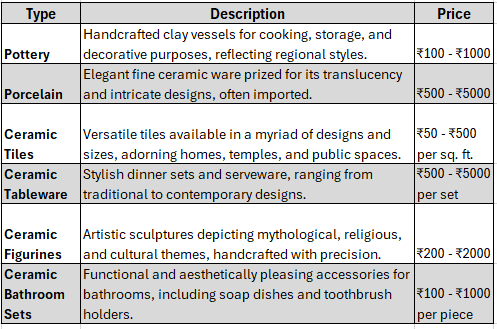Ceramic Products Journey
Unveiling the Enduring Splendor of Ceramic Products: A Journey through History, Varieties, and Significance in India


Introduction:
Ceramic products have been an integral part of Indian culture and daily life for centuries, blending practicality with artistic finesse. From the ancient civilizations of the Indus Valley to modern Indian households, ceramics have held a special place, reflecting the country's rich heritage and creativity. In this blog, we delve into the vibrant history, diverse types, price ranges, and the profound significance of ceramic products in the Indian market.
History of Ceramic Products in India:
India boasts a rich legacy of ceramic craftsmanship dating back to ancient times. Archaeological excavations have unearthed terracotta artifacts from the Indus Valley Civilization, showcasing the early mastery of pottery for utilitarian and ceremonial purposes. Over the centuries, Indian artisans honed their skills, producing exquisite ceramic ware ranging from intricately painted tiles to delicately sculpted figurines. Today, India continues to embrace its ceramic heritage while incorporating modern techniques and designs into the production process.
Types of Ceramic Products in the Indian Market:


Importance of Ceramic Products in the Indian Context:
Cultural Heritage: Ceramic products embody the rich cultural tapestry of India, with each region contributing unique styles and techniques.
Household Essentials: From cooking vessels to bathroom accessories, ceramics fulfill essential needs in Indian households, offering durability and hygiene.
Decorative Art: Ceramic tiles adorn homes, temples, and public spaces, adding a touch of elegance and color to architectural spaces.
Rituals and Festivals: Ceramics play a significant role in religious ceremonies and festivals, symbolizing purity and auspiciousness.
Economic Livelihood: The ceramic industry provides employment opportunities to a vast number of artisans and workers across the country, sustaining livelihoods and preserving traditional crafts.
Conclusion:
As we traverse through the realms of history, culture, and craftsmanship, the allure of ceramic products in the Indian market shines brightly. From the humble pottery of yesteryears to the sophisticated porcelain of today, ceramics continue to weave a story of beauty, utility, and tradition in the fabric of Indian society. Let us celebrate and cherish these timeless treasures, honoring the artisans who keep the legacy alive while embracing the innovations that propel ceramic art into the future.